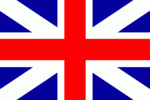The Introduction of the Union Jack
The Union Jack hasn't always been the flag of the United Kingdom. In fact, the United Kingdom hasn't always been called that. Many years ago, what we now call the United Kingdom was actually separate countries: England, Scotland, Wales, and Ireland. (Only Northern Ireland is now part of the United Kingdom.) In 1603, King James VI of Scotland became also King James I of England. This was called the "Grand Union."
When Northern Ireland became part of the mix in 1801, the flag as we know it today was born. Thus, the flag that signifies the United Kingdom is a familiar one. (Check out this illustration, which demonstrates the progression of the "unified" flags.) |
|
Social Studies for Kids
copyright 2002–2025
David White



 It didn't happen overnight, but it did happen. The flag was unveiled on April 12, 1606. It wasn't really favored by either English or Scottish. The Scottish people were angry that their flag now had a big red cross in the middle of it. The English people were angry that the white background from their flag had disappeared. But it stayed the "official" flag for many years.
It didn't happen overnight, but it did happen. The flag was unveiled on April 12, 1606. It wasn't really favored by either English or Scottish. The Scottish people were angry that their flag now had a big red cross in the middle of it. The English people were angry that the white background from their flag had disappeared. But it stayed the "official" flag for many years.
